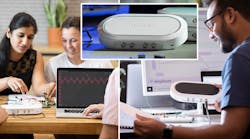Portable Eight-Function Instrumentation Module Serves Students, Professionals
Putting multiple test instruments into a common enclosure to save space, simplify use, minimize test-lead clutter, and reduce cost is not a new idea, as evidenced by the classic Simpson 260 VOM (volt-ohm-millimeter) introduced in the late 1930s (Fig. 1), with many still in use (see References).
But times, technologies, and user needs have changed dramatically, and that’s where the Moku:Go family from Liquid Instruments Inc. fits. This multi-instrument electronic-engineering lab in a sleek enclosure primarily targets engineering and STEM students at all levels, as well as professionals whose needs can be satisfied by its performance capabilities and specifications. Let‘s be real—not everyone is doing gigahertz-range RF work, especially “experimenters” and those with sensor and transducer-focused projects.
The unit (Fig. 2) is both compact and carry-friendly due to its diminutive size (9.4 inches/24 cm × 5.1 inches/13 cm × 1.5 inches/3.8 cm high) and modest weight of about 1.7 pounds/750 grams). The basic M0 model ($499) includes eight instruments and requires user-provided external power supplies, while the mid-range M1 version ($549) adds two programmable supplies rated −5 V to +5 V at 150 mA and 0 to +16 V at 150 mA, available via rear-panel connectors. The top-of-the line M2 version ($599) adds two more programmable supplies, each specified for +0.6 V to +5 V and 60 mA to 1 A; it also adds a rear-panel Ethernet port.
Signal I/O is via well-known BNC connectors while power connectors use tried-and-true banana plugs. The device can be powered through the magnetic power adapter or a USB-C cable. There’s also Wi-Fi connectivity in all three models.
Of course, what matters for the student or engineer are the specific instrumentation functions in the Moku:Go system:
- Arbitrary waveform generator
- Data logger
- Frequency-response analyzer
- Logic analyzer/pattern Generator
- Oscilloscope/voltmeter
- PID controller
- Spectrum analyzer
- Waveform generator
Note that having a PID controller—a widely used closed-loop control function—is somewhat unusual in a basic instrumentation arrangement. However, it’s an invaluable resource for controlling heaters, motion, and many other real-world setups and experiments that go beyond basic test/measurement stimulus and data acquisition. The Moku:Go system also offers 16 channels of high-speed digital I/O.
One of the other potential virtues of multiple instruments in a common box is the opportunity to link them at a higher level and even achieving some system-level synergy, beginning with its high-level setup screen (Fig. 3). Users can invoke the Moku:Go App for Mac or Windows to configure any of the eight instruments, and the Moku:Go ties it all together with availability of a programming environment with API support for Python, MATLAB, and LabView.
Given the inherently diverse nature of this instrumentation octet, it hard to characterize performance with just a few numbers. The vendor website includes a documentation page with links to individual datasheets that provide more details for each unit along with the user’s manual for each.
As one example, the top-level specifications for the two-channel oscilloscope is 12-bit resolution, ±5-V or ±25-V range, and 30-MHz bandwidth with sampling at up to 125 Msamples/s (Fig. 4). The waveform generator delivers waveforms up to 20 MHz and the spectrum analyzer can handle signals from dc to 30 MHz, with resolution bandwidth as low as 470 mHz over a minimum span of 100 Hz.
Is the Moku:Go the “does-it-all” multifunction lab instrument that’s the solution for all test and measurement situations? Certainly not. But a large fraction of users and applications will likely be satisfied by the convenience, form factor, and price, while finding that its performance is more than adequate for what they’re doing. This can be clearly seen in the many case studies and application examples that Liquid Instruments has posted here and here, respectively.
The reality is that many test-bench lab setups centered on hands-on electronic, mechanical, and biological projects—especially those dealing with physical world and sensor I/O—operate with functions and sampling/update rates at tens of megahertz or megasamples/second rather than gigahertz and gigasamples/second.
References
Electronic Products, “What’s It Worth: Simpson Electric Company Testers”
Simpson Electric, “History”




